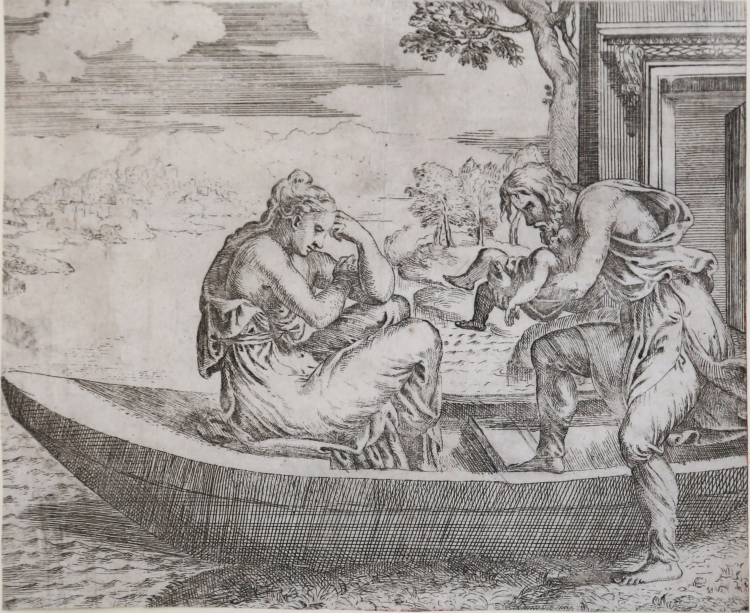




| Reference: | S10411 |
| Author | Battista ANGOLO del Moro |
| Year: | 1550 ca. |
| Measures: | 210 x 174 mm |



| Reference: | S10411 |
| Author | Battista ANGOLO del Moro |
| Year: | 1550 ca. |
| Measures: | 210 x 174 mm |
Etching, 1550 circa, after a subject by Giulio Romano.
Magnificent example of an extremely rare work, ascribed to Torbido dal Moro by Passavant.
Printed on contemporary laid paper with "sun in the circle" watermark, trimmed inside the plate sign with the loss of a part, in excellent condition.
He work is also known with the name of "Woman on a boat with man and child".
|
Passavant VI. P. 139, Meyer II, 41.15; Bellini (Ghisi) p.37, 3/1.
|
Battista ANGOLO del Moro (Attivo a Verona e Venezia nella seconda metà del XVI secolo)
|
Battista dell’Angolo married the daughter of Francesco Torbido (called il Moro) and added her family nickname to his surname. Battista practised as a decorative fresco painter in the Veneto in the second half of the 16th century and was the first of an important group of etchers active in and around Verona and Venice at that time. His Mannerist style was perpetuated by his sons (2) Marco dell’Angolo del Moro and (3) Giulio dell’Angolo del Moro. Marco also followed in his father’s footsteps as an etcher, whereas Giulio was active also as a sculptor. Battista dell’Angolo (b Verona, c. 1515; d ?Verona, 1573 or after). Painter, draughtsman and etcher. He was trained by his father-in-law, whose decorative painting style was much influenced by the work of Titian and Giulio Romano. Much of Battista’s paintings, on the façades of churches and palazzi in the Marches, has been lost (due to the damp and salty coastal environment), but the recently restored façade of the Palazzo Pindemonti, Verona, reveals his talents as a fresco painter. There are other surviving paintings by Battista in the churches of S Eufemia (Paul before Ananias), S Stefano (An Angel Presenting the Palms of Martyrdom to the Innocents) and S Fermo Maggiore, all in Verona, and also in the Mantua Cathedral. In 1557 Battista, assisted by his son Marco, painted fresco decorations in the Palazzo Treviso at Murano, where Veronese was also active.
|
|
Passavant VI. P. 139, Meyer II, 41.15; Bellini (Ghisi) p.37, 3/1.
|
Battista ANGOLO del Moro (Attivo a Verona e Venezia nella seconda metà del XVI secolo)
|
Battista dell’Angolo married the daughter of Francesco Torbido (called il Moro) and added her family nickname to his surname. Battista practised as a decorative fresco painter in the Veneto in the second half of the 16th century and was the first of an important group of etchers active in and around Verona and Venice at that time. His Mannerist style was perpetuated by his sons (2) Marco dell’Angolo del Moro and (3) Giulio dell’Angolo del Moro. Marco also followed in his father’s footsteps as an etcher, whereas Giulio was active also as a sculptor. Battista dell’Angolo (b Verona, c. 1515; d ?Verona, 1573 or after). Painter, draughtsman and etcher. He was trained by his father-in-law, whose decorative painting style was much influenced by the work of Titian and Giulio Romano. Much of Battista’s paintings, on the façades of churches and palazzi in the Marches, has been lost (due to the damp and salty coastal environment), but the recently restored façade of the Palazzo Pindemonti, Verona, reveals his talents as a fresco painter. There are other surviving paintings by Battista in the churches of S Eufemia (Paul before Ananias), S Stefano (An Angel Presenting the Palms of Martyrdom to the Innocents) and S Fermo Maggiore, all in Verona, and also in the Mantua Cathedral. In 1557 Battista, assisted by his son Marco, painted fresco decorations in the Palazzo Treviso at Murano, where Veronese was also active.
|